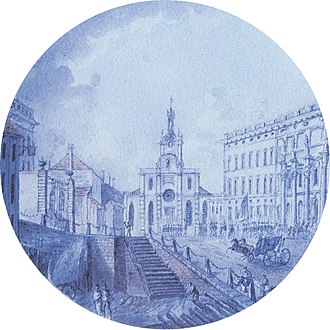Bollhuset [Stockholm] (Q10132)
From CanonBase
Theatre building in Stockholm, Sweden, opened in 1627
- Bollhuset
| Language | Label | Description | Also known as |
|---|---|---|---|
| English | Bollhuset [Stockholm] | Theatre building in Stockholm, Sweden, opened in 1627 |
|
Statements
59°19'32.999"N, 18°4'19.999"E
0 references
Bollhuset was the first theater in Sweden, founded in 1627. The building was first used for sports, with intermediate foreign theater companies performing for the aristocracy. Over time the building was redecorated and used permanently as a theater, inviting the general public. In the 18th century, with royal decrees changing the cultural landscape, the theater became a mainstay in the city of Stockholm, until 1793, when it was demolished. (English)
0 references
Bollhuset, or Bollhusteatern (Ball house Theater) is the first recorded theatre in Sweden and first real theater building in the whole of Scandinavia. Established in 1627, Bollhuset was first used for “Jeu de Paume”, a tennis-like sport played with the palm of your hand. Located near the royal palace Tre Kronor (Three Crowns), it was commissioned by the royal court for use by the aristocracy. Originally owned by Charles Boit (jr), the building was inherited by his widow, until it was taken over by the crown in 1699, to be given to the French court theater. (English)
0 references
During the 17th century Bollhuset was used for foreign travelling theater companies, as was common for ball houses. Foreign actors were primarily from Germany and the Netherlands. The plays were performed for the public even though the general population were not learnt in foreign languages. As such, performances became more visual to attract attention from the public, ranging from use of fireworks, tightrope-walking and pantomime. The French-speaking theater company, La Troupe de Roi the Suede, were commonly performing at Bollhuset as French language court theater was considered compulsory amongst the court. Bollhusteatern was permanently redecorated into a theater to be used until 1706, closed as a result of the Great Northern War (1700-1721). Once reopened, performances inside the building ranged from political in nature to banquets and masquerade balls. (English)
0 references
In 1771, Gustav III fired the French theater company, wishing to grand Swedish actors a chance to play on their own and for Swedish theater culture to develop independently. Plays were not received well by critics at the time, but still considered a success by the nature of having them performed in Swedish. In 1781, a French theater group was hired to help teach the Swedish theater group. However, they established their own performances to be play alongside the Swedish group, creating a French theater and a Swedish theater. (English)
0 references
In April 1787, Adolf Fredrik Ristell received the rights to arrange Swedish acting at Bollhusteatern. He received several written contributions from different playwrights, even from the king himself, also writing several himself. In 1788, director Ristell fled out of the country with 13000 Swedish riksdaler in debt, having left the theater in bankruptcy. The actors then controlled the theater cooperatively, with insight and protection from the king. Bollhuset was used until 1793, when it was considered too dilapidated, and as a result, torn down. (English)
0 references
1667
0 references
1627
0 references
1792
0 references
1721
0 references
